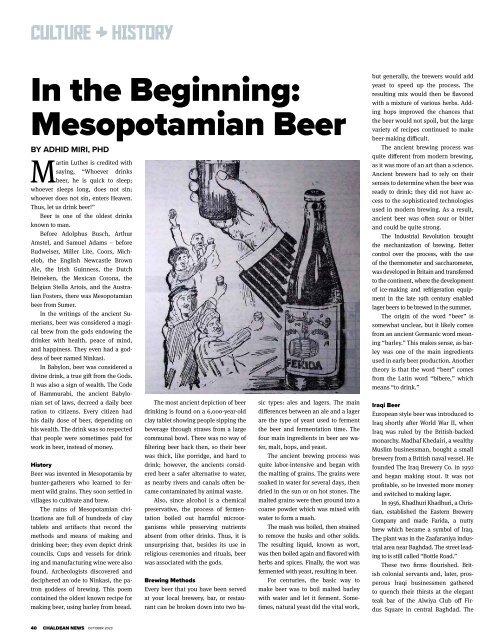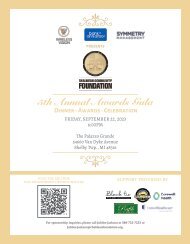Create successful ePaper yourself
Turn your PDF publications into a flip-book with our unique Google optimized e-Paper software.
CULTURE & HISTORY<br />
In the Beginning:<br />
Mesopotamian Beer<br />
BY ADHID MIRI, PHD<br />
Martin Luther is credited with<br />
saying, “Whoever drinks<br />
beer, he is quick to sleep;<br />
whoever sleeps long, does not sin;<br />
whoever does not sin, enters Heaven.<br />
Thus, let us drink beer!”<br />
Beer is one of the oldest drinks<br />
known to man.<br />
Before Adolphus Busch, Arthur<br />
Amstel, and Samuel Adams – before<br />
Budweiser, Miller Lite, Coors, Michelob,<br />
the English Newcastle Brown<br />
Ale, the Irish Guinness, the Dutch<br />
Heineken, the Mexican Corona, the<br />
Belgian Stella Artois, and the Australian<br />
Fosters, there was Mesopotamian<br />
beer from Sumer.<br />
In the writings of the ancient Sumerians,<br />
beer was considered a magical<br />
brew from the gods endowing the<br />
drinker with health, peace of mind,<br />
and happiness. They even had a goddess<br />
of beer named Ninkasi.<br />
In Babylon, beer was considered a<br />
divine drink, a true gift from the Gods.<br />
It was also a sign of wealth. The Code<br />
of Hammurabi, the ancient Babylonian<br />
set of laws, decreed a daily beer<br />
ration to citizens. Every citizen had<br />
his daily dose of beer, depending on<br />
his wealth. The drink was so respected<br />
that people were sometimes paid for<br />
work in beer, instead of money.<br />
History<br />
Beer was invented in Mesopotamia by<br />
hunter-gatherers who learned to ferment<br />
wild grains. They soon settled in<br />
villages to cultivate and brew.<br />
The ruins of Mesopotamian civilizations<br />
are full of hundreds of clay<br />
tablets and artifacts that record the<br />
methods and means of making and<br />
drinking beer; they even depict drink<br />
councils. Cups and vessels for drinking<br />
and manufacturing wine were also<br />
found. Archeologists discovered and<br />
deciphered an ode to Ninkasi, the patron<br />
goddess of brewing. This poem<br />
contained the oldest known recipe for<br />
making beer, using barley from bread.<br />
The most ancient depiction of beer<br />
drinking is found on a 6,000-year-old<br />
clay tablet showing people sipping the<br />
beverage through straws from a large<br />
communal bowl. There was no way of<br />
filtering beer back then, so their beer<br />
was thick, like porridge, and hard to<br />
drink; however, the ancients considered<br />
beer a safer alternative to water,<br />
as nearby rivers and canals often became<br />
contaminated by animal waste.<br />
Also, since alcohol is a chemical<br />
preservative, the process of fermentation<br />
boiled out harmful microorganisms<br />
while preserving nutrients<br />
absent from other drinks. Thus, it is<br />
unsurprising that, besides its use in<br />
religious ceremonies and rituals, beer<br />
was associated with the gods.<br />
Brewing Methods<br />
Every beer that you have been served<br />
at your local brewery, bar, or restaurant<br />
can be broken down into two basic<br />
types: ales and lagers. The main<br />
differences between an ale and a lager<br />
are the type of yeast used to ferment<br />
the beer and fermentation time. The<br />
four main ingredients in beer are water,<br />
malt, hops, and yeast.<br />
The ancient brewing process was<br />
quite labor-intensive and began with<br />
the malting of grains. The grains were<br />
soaked in water for several days, then<br />
dried in the sun or on hot stones. The<br />
malted grains were then ground into a<br />
coarse powder which was mixed with<br />
water to form a mash.<br />
The mash was boiled, then strained<br />
to remove the husks and other solids.<br />
The resulting liquid, known as wort,<br />
was then boiled again and flavored with<br />
herbs and spices. Finally, the wort was<br />
fermented with yeast, resulting in beer.<br />
For centuries, the basic way to<br />
make beer was to boil malted barley<br />
with water and let it ferment. Sometimes,<br />
natural yeast did the vital work,<br />
but generally, the brewers would add<br />
yeast to speed up the process. The<br />
resulting mix would then be flavored<br />
with a mixture of various herbs. Adding<br />
hops improved the chances that<br />
the beer would not spoil, but the large<br />
variety of recipes continued to make<br />
beer-making difficult.<br />
The ancient brewing process was<br />
quite different from modern brewing,<br />
as it was more of an art than a science.<br />
Ancient brewers had to rely on their<br />
senses to determine when the beer was<br />
ready to drink; they did not have access<br />
to the sophisticated technologies<br />
used in modern brewing. As a result,<br />
ancient beer was often sour or bitter<br />
and could be quite strong.<br />
The Industrial Revolution brought<br />
the mechanization of brewing. Better<br />
control over the process, with the use<br />
of the thermometer and saccharometer,<br />
was developed in Britain and transferred<br />
to the continent, where the development<br />
of ice-making and refrigeration equipment<br />
in the late 19th century enabled<br />
lager beers to be brewed in the summer.<br />
The origin of the word “beer” is<br />
somewhat unclear, but it likely comes<br />
from an ancient Germanic word meaning<br />
“barley.” This makes sense, as barley<br />
was one of the main ingredients<br />
used in early beer production. Another<br />
theory is that the word “beer” comes<br />
from the Latin word “bibere,” which<br />
means “to drink.”<br />
Iraqi Beer<br />
European style beer was introduced to<br />
Iraq shortly after World War II, when<br />
Iraq was ruled by the British-backed<br />
monarchy. Madhaf Khedairi, a wealthy<br />
Muslim businessman, bought a small<br />
brewery from a British naval vessel. He<br />
founded The Iraq Brewery Co. in 1950<br />
and began making stout. It was not<br />
profitable, so he invested more money<br />
and switched to making lager.<br />
In 1956, Khadhuri Khadhuri, a Christian,<br />
established the Eastern Brewery<br />
Company and made Farida, a nutty<br />
brew which became a symbol of Iraq.<br />
The plant was in the Zaafaraniya industrial<br />
area near Baghdad. The street leading<br />
to is still called “Bottle Road.”<br />
These two firms flourished. British<br />
colonial servants and, later, prosperous<br />
Iraqi businessmen gathered<br />
to quench their thirsts at the elegant<br />
teak bar of the Alwiya Club off Firdus<br />
Square in central Baghdad. The<br />
40 CHALDEAN NEWS <strong>OCTOBER</strong> <strong>2023</strong>

















